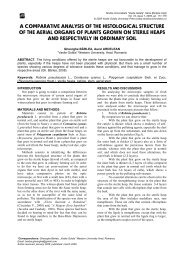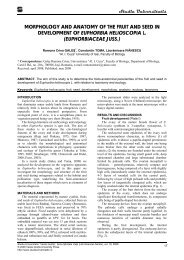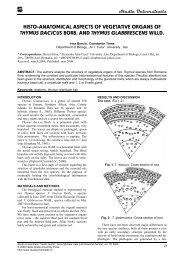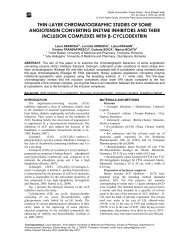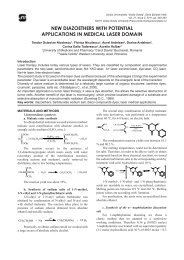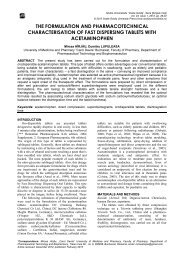flow cytrometric analysis of red blood cells in polycythemia vera
flow cytrometric analysis of red blood cells in polycythemia vera
flow cytrometric analysis of red blood cells in polycythemia vera
Create successful ePaper yourself
Turn your PDF publications into a flip-book with our unique Google optimized e-Paper software.
Gheorghe A., Rug<strong>in</strong>a Alx., Moicean A., Ardelean A., Bratos<strong>in</strong> D.<br />
Fig. 3 Comparative scann<strong>in</strong>g electron microscopy<br />
(SEM) <strong>of</strong> normal (M) and Polycythemia <strong>vera</strong> <strong>red</strong> <strong>blood</strong><br />
<strong>cells</strong> (PV). Details <strong>of</strong> some dysmorphic Polycythemia<br />
<strong>vera</strong> erythrocytes (a to f)<br />
Measurement <strong>of</strong> glycoconjugate sialylation<br />
Classically, the sialic acid residues which are<br />
situated <strong>in</strong> term<strong>in</strong>al position <strong>of</strong> the glycan moieties <strong>of</strong><br />
membrane glycoconjugates are conside<strong>red</strong> as<br />
antirecognition signals for phagocytic <strong>cells</strong>. Their<br />
removal by sialidases, by demask<strong>in</strong>g the penultimate β-<br />
galactosyl residues <strong>of</strong> glycans <strong>in</strong>duces the capture <strong>of</strong><br />
<strong>cells</strong> mediated by a specific lect<strong>in</strong> present <strong>in</strong> the<br />
macrophage membrane. As demonstrated by Figure 5,<br />
<strong>analysis</strong> by cyt<strong>of</strong>luorimetry <strong>of</strong> the b<strong>in</strong>d<strong>in</strong>g <strong>of</strong> FITClabeled<br />
lect<strong>in</strong>s specific for sialic acid and β-galactosyl<br />
residues shows that the means <strong>of</strong> fluorescence<br />
<strong>in</strong>tensity (MFI) for Maackia amurensis agglut<strong>in</strong><strong>in</strong><br />
MAA specify for α-1,3-l<strong>in</strong>ked sialic acids is<br />
much smaller (23.05) compa<strong>red</strong> to MFI for normal<br />
RBCs (47.88). After treatment (PVt), the MFI <strong>in</strong>crease<br />
to 36.77 value.<br />
This desialilation is also evidenced by Wheat germ<br />
agglut<strong>in</strong><strong>in</strong> (WGA) that b<strong>in</strong>ds to N-acetylglucosam<strong>in</strong>e,<br />
but also can <strong>in</strong>teract with some glycoprote<strong>in</strong>s via sialic<br />
acid residues. Sambucus nigra agglut<strong>in</strong><strong>in</strong> (SNA),<br />
specific for α-1,6-l<strong>in</strong>ked sialic acids also show a<br />
discrete desialilation.<br />
Fig. 4. Comparative <strong>flow</strong> cytometric histogram <strong>analysis</strong> <strong>of</strong> erythrocytes viability determ<strong>in</strong>ed by cell esterase activity<br />
measurement us<strong>in</strong>g Calce<strong>in</strong>-AM. Human normal <strong>red</strong> <strong>blood</strong> <strong>cells</strong> (M), <strong>red</strong> <strong>blood</strong> <strong>cells</strong> <strong>in</strong> Polycythaemia <strong>vera</strong> before (PV)<br />
and after treatment (PVt). Numbers represent fluorescence mean values (MFI). Abscissae: log scale green fluorescence<br />
<strong>in</strong>tensity <strong>of</strong> Calce<strong>in</strong> (FL1). Ord<strong>in</strong>ates: relative cell number. Number <strong>of</strong> counted <strong>cells</strong>: 10,000. Results presented are from<br />
one representative experiment <strong>of</strong> three performed.<br />
In the same way, as demonstrated by Figure 5,<br />
b<strong>in</strong>d<strong>in</strong>g <strong>of</strong> Ric<strong>in</strong>us comMunis agglut<strong>in</strong><strong>in</strong> (RCA 120 ),<br />
specific for β-galactosyl residues, has not been<br />
fixed more on Polycythemia <strong>vera</strong> <strong>red</strong> <strong>blood</strong> <strong>cells</strong><br />
(MFI=61.7) compa<strong>red</strong> to normal erythrocytes (76.73)<br />
or after treatment, when b<strong>in</strong>d<strong>in</strong>g is also lower (46.31),<br />
phenomenon that rema<strong>in</strong>s an enigma.<br />
Study <strong>of</strong> death by annex<strong>in</strong>-V-FITC labell<strong>in</strong>g<br />
Study <strong>of</strong> death by Annex<strong>in</strong>-V-FITC label<strong>in</strong>g<br />
phosphatidylser<strong>in</strong>e exposure on the outer leaflet <strong>of</strong><br />
plasma membrane is regarded as one <strong>of</strong> the signals<br />
allow<strong>in</strong>g macrophages to <strong>in</strong>gest erythrocytes. In<br />
Polycythaemia <strong>vera</strong> we did not observe any difference<br />
<strong>of</strong> phosphatidylser<strong>in</strong>e externalization between normal<br />
and Polycythemia <strong>vera</strong> RBCs. The value (1.48%) is <strong>in</strong><br />
32<br />
the limit <strong>of</strong> normal RBCs statistical value: 1.5 ± 1%<br />
(data not shown)<br />
Red <strong>blood</strong> <strong>cells</strong> <strong>in</strong> Polycythemia <strong>vera</strong> express<br />
active caspases-8 and 3<br />
We then assessed whether erythrocytes <strong>in</strong><br />
Polycythemia <strong>vera</strong> express active caspases. In order to<br />
precise the nature <strong>of</strong> activated caspases, we used the<br />
CaspGLOW TM specific cell permeable fluorogenic<br />
substrates FITC-IETD-fmk and FITC-DEVD-fmk,<br />
which are labeled <strong>in</strong>hibitors <strong>of</strong> caspases-8 and -3,<br />
respectively.<br />
As shown <strong>in</strong> Figure 6, a significant fluorescence<br />
was detected by <strong>flow</strong> cytometry. Thus, by compar<strong>in</strong>g<br />
% <strong>of</strong> <strong>cells</strong> with active caspases, can be observed a<br />
lower level <strong>of</strong> caspase-8 active <strong>in</strong> the RBCS <strong>of</strong><br />
Studia Universitatis “Vasile Goldiş”, Seria Şti<strong>in</strong>ţele Vieţii<br />
Vol. 21, issue 1, 2011, pp. 29-35<br />
© 2011 Vasile Goldis University Press (www.studiauniversitatis.ro)



